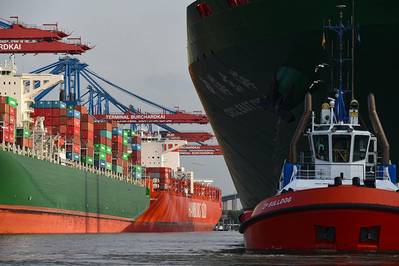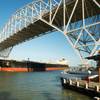The Port of Hamburg achieved its best-ever result in 2014, reporting total throughput of 145.7 million tons, representing growth of 4.8 percent. Up by 6.1 percent at 102.7 million tons, general cargo throughput was outstanding. A 1.7 percent increase in bulk cargo throughput to 43 million tons also contributed to the new record for Germany’s largest universal port.
In 2014 the Port of Hamburg set a new record for seaborne cargo handling. Never before had such cargo volumes been loaded and discharged in the Port of Hamburg.
“This year of throughput records was possible because port customers and shipowners rely on Hamburg and value our port’s high quality performance. Along with its excellent liner services and links with markets in Germany and abroad, the outstanding level of performance by the port and its many providers of cargo handling, logistics and transport services continue to prove convincing for its many customers. Internationally, Hamburg belongs in the Champions League of world ports, achieving above-average growth compared to its European competitors,” emphasized Axel Mattern of Port of Hamburg Marketing (HHM)’s Executive Board in presenting the port’s results.
“I am very pleased with the annual result. It shows how important it is to develop and implement intelligent solutions for the port. With our smartPORT strategy, we are set on precisely the right course for the future of the Port of Hamburg," said Jens Meier, CEO of Hamburg Port Authority.
The Port of Hamburg employs around 151,000 people. With added value totaling almost 20 billion euros, the port is also of crucial importance for the entire German national economy. To keep the universal port on a continued growth course, in addition to the dredging and widening of the navigation channel on the Lower and Outer Elbe, in Axel Mattern’s view the upgrading and expansion of access and dispersal corridors for the transport of growing cargo volumes by rail, truck and inland waterway craft are vital. Axel Mattern and his Executive Board colleague Ingo Egloff underline that the fresh throughput record had been achieved despite the enormous number of roadworks in progress in the Hamburg area.
“That suggests excellent site coordination and tremendous flexibility in the port and transport industry, which made tremendous efforts to maintain reliability in providing their services in the face of tough restraints on cargo transport and handling,” Mattern said.
Port of Hamburg Marketing discharges an essential function as an interface communicating with port customers. As part of its extensive marketing effort, HHM provides information on cargo transport and handling developments in the port and the region. “In this way we strengthen customer loyalty and deepen contacts between the business in the port and the customers. We canvass very specifically for the port itself and the Hamburg Metropolitan Region,” said Mattern, who is keen to acquire many new member companies from the port and transport sectors, along with logistics and industry.
At 9.7 million TEU (20-ft standard containers), Hamburg’s container throughput achieved a gain of 5.1 percent, above average for ports in Northern Europe while remaining just below a fresh record 10 million TEU mark that is now the aim for 2015. Strong growth in container throughput is primarily attributable to a 9.8 percent jump in container services with China. With around 3 million TEU, the Middle Kingdom is Hamburg’s most significant partner for container transport. Among Hamburg’s Top Ten trading partners, Poland with 395,000 TEU (up by 22.6 percent) and India with 232,000 TEU (up by 14.9 percent) both posted fresh throughput records for container traffic. Overall, the development of transhipment services in the Baltic region, that in 2014 only reached slight growth of 0.5 percent, was affected by the anticipated downturn in container traffic with Russia. Hamburg’s second largest market partner on container services may have held its place. However, the weakness of the rouble and the repercussions of trade sanctions meant that throughput in 2014 did not exceed 662,000 TEU (down 7.8 percent).
“In 2014 Hamburg’s feat of boosting container throughput by 5.1 percent meant that it did extremely well by comparison with its European competitors. Hamburg is gaining market share in this segment. Average container throughput in the major ports of Northern Europe was up by 4.2 percent. Hamburg has thus consolidated its position as Europe’s second largest container port. In the worldwide ranking of container ports, Hamburg remains in 15th place,” Mattern explained, also pointing out that in handling 8.5 million TEU of loaded containers (up by 5.5 percent), Hamburg has been able to report an additional record in 2014. At 87 percent, of Europe’s major container ports Hamburg achieved the highest proportion of loaded boxes in its throughput totals.
Throughput of non-containerized general cargo reached 2 million tons (up by 3.8 percent) in 2014. Growth was fuelled by exports of iron, steel, paper and timber, and a notable 19.6 percent increase in imports of tropical fruit that reached 188,000 tons.
In 2014 bulk cargo throughput rose by 1.7 percent to a total of 43 million tons, contributing with a share of 29.5 percent of total throughput to the Port of Hamburg’s excellent result on the year. Suction cargo at 8.2 million tons (up by 1.5 percent) and grab cargo at 20.4 million tons (up by 3.5 percent) helped to produce a fresh rise in throughput of seaborne cargoes in 2014. Growth was powered mainly by coal imports at 6.1 million tons (up by 6.9 percent) and ore imports at 9.9 million tons (up by 4.4 percent). The positive development of throughput in the suction cargo segment was attributable to grain handling, rising by 6.7 percent to reach 3.7 million tons. Grain was exported to North and West Africa in growing quantities. Throughput in the liquid cargo segment totaled 14.4 million tons (down 0.8 percent), just failing to match the previous year’s good figure. Apart from lower imports of crude oil, the downturn here was caused by slight falls in imports of palm and soya oil as well as chemical products, and restructuring at a leading Hamburg refinery. So 12.8 percent growth in exports to 4.5 million tons was not sufficient to offset decreases in liquid cargo imports.
For 2015 the Port of Hamburg’s marketing organization reckons with a further climb in throughput of seaborne cargoes. By the end of the year the total could reach 149 million tons, with the 10 million TEU mark achieved for containers. Further growth in seaborne foreign trade with core markets is however essential for achievement of these figures.











